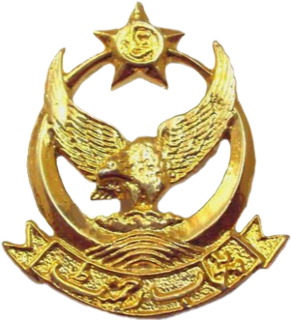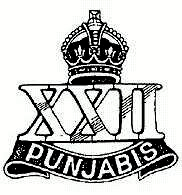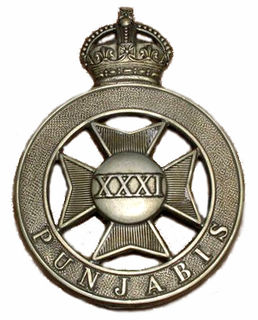
The Punjab Regiment is an infantry regiment of the Pakistan Army. It was raised in its current form in 1956, following the amalgamation of the 1st, 14th, 15th and 16th Punjab regiments that were inherited by the Dominion of Pakistan from the British Indian Army upon the Partition of India. Since then, the regiment has expanded in size to 74 battalions.

The 16th Punjab Regiment was an infantry regiment of the British Indian Army from 1922 to 1947. Upon the Partition of India, it was transferred to the newly-raised Pakistan Army. It ceased to exist in this form in 1956, when it was amalgamated with the 1st, 14th and 15th Punjab regiments to form the Punjab Regiment, an existing infantry regiment of the Pakistan Army.

The 1st Punjab Regiment was an infantry regiment of the British Indian Army from 1922 to 1947. Upon the Partition of India, it was transferred to the newly-raised Pakistan Army. It ceased to exist in this form in 1956, when it was amalgamated with the 14th, 15th and 16th Punjab regiments to form the Punjab Regiment, an existing infantry regiment of the Pakistan Army.

The 14th Punjab Regiment was a regiment of the British Indian Army from 1922 to 1947. It was transferred to the Pakistan Army on independence in 1947, and amalgamated with the 1st, 15th and 16th Punjab Regiments in 1956, to form the Punjab Regiment.

The 66th Punjabis was an infantry regiment of the British Indian Army. It was raised in 1761 as the 7th Battalion of Coast Sepoys. It was designated as the 66th Punjabis in 1903 and became 2nd Battalion 1st Punjab Regiment in 1922. In 1947, it was allocated to the Pakistan Army, where it continues to exist as 2nd Battalion The Punjab Regiment.

The 76th Punjabis was an infantry regiment of the British Indian Army. It was raised by Captain Thomas Lane at Trichonopoly on 16 December 1776, as the 16th Carnatic Battalion. It was designated as the 76th Punjabis in 1903 and became the 3rd Battalion 1st Punjab Regiment in 1922. In 1947, it was allocated to the Pakistan Army, where it continues to exist as 3rd Battalion The Punjab Regiment.

The 82nd Punjabis was an infantry regiment of the British Indian Army. It was raised in 1788, as the 29th Madras Battalion. It was designated as the 82nd Punjabis in 1903 and became the 5th Battalion 1st Punjab Regiment in 1922. In 1947, it was allocated to the Pakistan Army, where it continues to exist as 4th Battalion The Punjab Regiment.

The 84th Punjabis was an infantry regiment of the British Indian Army. It was raised by Captain Donald Macdonald at Vellore on 12 August 1794, as the 34th Battalion of Madras Native Infantry. It was designated as the 84th Punjabis in 1903 and became the 10th (Training) Battalion, 1st Punjab Regiment in 1922. In 1943, it was converted into the 1st Punjab Regimental Centre. In 1947, the 1st Punjab Regiment was allocated to the Pakistan Army. In 1956, the 1st, 14th, 15th and 16th Punjab Regimental Centres where amalgamated to form the Punjab Regimental Centre.

The 29th Punjabis was an infantry regiment of the British Indian Army. It was raised in 1857, as the 21st Regiment of Punjab Infantry. It was designated as the 29th Punjabis in 1903 and became 10th (Training) Battalion of 15th Punjab Regiment in 1922. In 1943, it was converted into the 15th Punjab Regimental Centre. In 1947, the 15th Punjab Regiment was allocated to the Pakistan Army. In 1956, the 1st, 14th, 15th and 16th Punjab Regimental Centres where amalgamated to form the Punjab Regimental Centre.

The 91st Punjabis was an infantry regiment of the British Indian Army. The regiment was raised in 1800 as a battalion of Madras Native Infantry. It was designated as the 91st Punjabis in 1903 and became 3rd Battalion 8th Punjab Regiment in 1922. In 1947, it was allocated to Pakistan Army, where it continues to exist as 3rd Battalion of The Baloch Regiment.

The 9th Bhopal Infantry was an infantry regiment of the British Indian Army.It was raised by Nawab of Bhopal in 1818 near Sehore. It was re-raised in 1859, as the Bhopal Levy. The regiment was disbanned for participating in war against British during 1857. It was designated as the 9th Bhopal Infantry in 1903 and became 4th Battalion (Bhopal) 16th Punjab Regiment in 1922. In 1947, it was allocated to the Pakistan Army, where it continues to exist as 17th Battalion The Punjab Regiment / 17 Punjab Haidri.

The 19th Punjabis was an infantry regiment of the British Indian Army. It was raised in 1857, as the 7th Regiment of Punjab Infantry. It was designated as the 19th Punjabis in 1903 and became 1st Battalion 14th Punjab Regiment i.e. 1/14 Punjab Regiment in 1922. In 1947, it was allocated to the Pakistan Army, where it continues to exist as 5th Battalion The Punjab Regiment.
The 21st Punjabis were an infantry regiment of the British Indian Army. It was raised in 1857, as the 11th Regiment of Punjab Infantry. It was designated as the 21st Punjabis in 1903 and became 10th (Training) Battalion of 14th Punjab Regiment in 1922. In 1943, it was converted into the 14th Punjab Regimental Centre. In 1947, the 14th Punjab Regiment was allocated to the Pakistan Army. In 1956, the 1st, 14th, 15th and 16th Punjab Regimental Centres where amalgamated to form the Punjab Regimental Centre.

The 22nd Punjabis was an infantry regiment of the British Indian Army. It was raised in 1857, as the 11th Regiment of Punjab Infantry. It was designated as the 22nd Punjabis in 1903 and became 3rd Battalion 14th Punjab Regiment in 1922. In 1947, it was allocated to the Pakistan Army, where it continues to exist as 7th Battalion The Punjab Regiment.

The 26th Punjabis were an infantry regiment of the British Indian Army. It was raised in 1857, as the 18th Regiment of Punjab Infantry. It was designated as the 26th Punjabis in 1903 and became 2nd Battalion 15th Punjab Regiment in 1922. In 1947, it was allocated to the Pakistan Army, where it continues to exist as 10th Battalion The Punjab Regiment.

The 28th Punjabis were an infantry regiment in the British Indian Army. It was raised in 1857, as the 20th Regiment of Punjab Infantry. It was designated as the 28th Punjabis in 1903 and became 4th Battalion 15th Punjab Regiment in 1922. In 1947, it was allocated to the Pakistan Army, where it continues to exist as 12th Battalion The Punjab Regiment.

The 30th Punjabis were an infantry regiment of the British Indian Army. It was raised in 1857, as the 22nd Regiment of Punjab Infantry. It was designated as the 30th Punjabis in 1903 and became 1st Battalion 16th Punjab Regiment in 1922. In 1947, it was allocated to the Pakistan Army, where it continues to exist as 13th Battalion The Punjab Regiment.

The 31st Punjabis was an infantry regiment of the British Indian Army. It was raised in 1857, as Van Cortlandt's Levy. The regiment was designated as the 31st Punjabis in 1903 and became 2nd Battalion 16th Punjab Regiment in 1922. In 1947, it was allocated to the Pakistan Army, where it continues to exist as 14th Battalion The Punjab Regiment.

The 33rd Punjabis was an infantry regiment of the British Indian Army. It was raised in 1857, as the Allahabad Levy. It was designated as the 33rd Punjabis in 1903 and became 3rd Battalion 16th Punjab Regiment in 1922. In 1947, it was allocated to the Pakistan Army, where it continues to exist as 15th Battalion The Punjab Regiment.

The 46th Punjabis were an infantry regiment of the British Indian Army. It was raised in 1900, as the 46th (Punjab) Regiment of Bengal Infantry. It was designated as the 46th Punjabis in 1903 and became 10th (Training) Battalion of 16th Punjab Regiment in 1922. In 1943, it was converted into the 16th Punjab Regimental Centre. In 1947, the 16th Punjab Regiment was allocated to the Pakistan Army. In 1956, the 1st, 14th, 15th and 16th Punjab Regimental Centres where amalgamated to form the Punjab Regimental Centre.




















